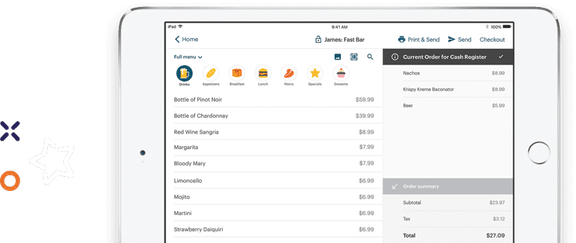Breakups are never easy. But when it comes to POS providers, sometimes they’re necessary.
For many restaurateurs, the POS they originally fell in love with has begun to lose its luster. Things have started slowing down, the interface has begun to look a little outdated, and customer support is inconsistent (at best). To put it bluntly, the honeymoon phase is over.
If this sounds a little familiar, it might mean that you’ve outgrown your restaurant POS. And that’s okay! Not every relationship is meant to last forever, and you might be ready for bigger and better things.
Things have started slowing down, the restaurant POS interface has begun to look a little outdated, and customer support is inconsistent (at best).
But before you start giving your number out to new providers, there are a few things to know about switching POS systems. From getting out of your current contract to migrating your menu, there are some important steps involved in getting set up with a new POS provider.
We’re here to make the transition a little smoother by covering everything you need to know about switching POS providers, including:
- The difference between legacy, cloud, and hybrid POS systems
- Five red flags that signal it’s time to switch
- How to switch from a legacy system to a cloud or hybrid POS
- How to switch from a cloud POS to another cloud provider
Already in the process of changing providers? Get our Ultimate Guide to Switching POS Providers.

Switching your POS system doesn’t have to be a headache. Get the complete how-to.
Legacy, Cloud, and Hybrid POS Providers
Before you can consider switching POS providers, it’s important to know what you’re currently working with and the new POS system you want to use. Below, we break down the three different types of restaurant POS systems: legacy, cloud, and hybrid.

Legacy POS Systems
Restaurants that have been around for several years are often using legacy POS systems like Squirrel POS and Micros POS. These systems involve storing all the POS hardware and software on-site, which often takes up quite a bit of room – you’ve probably seen the bulky terminals that resemble decades-old computers. This kind of fixed setup means that all the sales data is stored on local servers and the system runs on a closed internal network. With a legacy system, your data can only be accessed on-site and a technician must be brought in each time a repair or upgrade is needed.
Legacy POS systems generally require an upfront fee for the installation of the hardware and software, and additional fees for software upgrades and ongoing maintenance. In total, a legacy system can run restaurants anywhere from $30,000 to $50,000 per year.
Modern POS Systems
Cloud POS Systems
With a cloud-based system, your data is stored on remote servers (“the cloud”), and you can access it via the Internet. This means that you can log into the system from any device as long as you have an Internet connection. Of course, the downside of a strictly cloud-based system is that if your Internet goes out, all your POS functions go out with it.
Unlike legacy systems, cloud POS providers charge a monthly subscription fee for the use of their software. Though subscription fees vary, the costs are still far less than a legacy POS at about $600 to $10,000 per year.
Hybrid POS Systems
A hybrid POS system is a bit like the best of both worlds. A hybrid POS is still a cloud-based platform, but it also has a hardwired, local connection in the restaurant. This setup means that you get all the convenience and flexibility of a cloud-based POS, but you also have a local connection to keep you up and running if the Internet goes down.
As for pricing, many hybrid POS systems follow the same monthly subscription fee-based structure as cloud-based systems.
When Should You Switch POS Providers? 5 Red Flags
You now have a better understanding of the types of POS systems out there. But how do you know when to trade in your old POS for a shiny new system?
It turns out, there are some pretty common red flags. Here are five warning signs that it’s time to switch POS providers:
1. It’s Complicated to Use and Manage
Not all POS systems are created equal and some come with a steeper learning curve than others. If your current system makes everyday tasks such as splitting checks or voiding items a complete headache, then you’re slowing down service and making life a lot harder for your staff.
Though every POS system requires a little bit of training, a good system should be intuitive enough for staff to complete basic tasks without any difficulty. If you’re currently using a legacy system, switching to a POS system with familiar hardware and software (such as iPads and iOS) can make it easier for staff to get up to speed.
2. It Slows Down Service
Speedy service is an essential part of great customer experience. So if your POS starts lagging as soon as things get busy, then you’re guaranteed to have some not-so-happy diners.
If speed is an issue with your current POS, it’s time to consider switching to a system that can keep up with the pace of your restaurant. A good POS system should be able to quickly process orders, payments, and more – even during peak hours.

3. It Can’t Be Accessed Remotely
Your POS reports and analytics are one of the powerful tools for restaurateurs. The problem is, this information isn’t always easy to access – especially if you’re using a legacy system that can only be accessed on-site.
Modern POS systems offer the flexibility and convenience of remote access. This means that you can comb through your sales report, check on current inventory, and even schedule your staff any time, any place, from any device. This allows you to stay connected to your business, even when you’re away from your restaurant.
4. It Requires a Multi-Year Contract
No one likes to be locked into a long-term phone contract and the same can be said about your POS provider. Restaurants are constantly changing and being stuck with a POS that no-longer serves your needs can make it impossible to grow or expand your business. This is often the case with legacy POS systems, which require you to purchase a software license, pay annual service fees, and sign multi-year contracts.
If you want to escape the constraints of a long-term contract, you should look for a POS provider with transparent pricing and month-to-month service. In most cases, cloud-based providers can offer you the flexibility of a monthly subscription and the option to cancel your subscription at any time.
5. It’s Too Expensive
Restaurant budgets are tight, and your POS shouldn’t be cutting into your bottom line. If you have an older legacy system, you might be spending a small fortune on repairs and maintenance just to keep the system up and running. Even if you’re with a cloud-based system costs can quickly add up if they’ve locked you in with pricey payment processing fees.
With so many new providers on the market, modern POS systems are more affordable than ever before. If you currently have a legacy POS system, switching to a cloud or hybrid system could mean less ongoing maintenance costs in exchange for a small monthly subscription fee. And if you’re stuck with a modern POS that doesn’t fit your budget, another provider may offer more competitive payment processing rates. Plus, some systems even integrate with a wider variety of processors so you can get the most economical rate.
If you spot any of these red flags, it’s a sign that you’re in dire need of a new POS system. Not only does a slow or complicated POS make it more difficult to manage your business, it can also impact the overall customer experience.
Of course, just because you haven’t spotted any red flags, doesn’t mean you shouldn’t keep your options open. For some restaurants, a lack of key features or limited payment options may also be signs that it’s time to switch POS providers.

How to Switch POS Providers
If some of those warning signs sound uncomfortably familiar, it’s time to switch POS providers.
How you make the switch will simply depend on what type of POS system you’re currently using: legacy or modern.
Switching from a Legacy System to a Cloud or Hybrid POS
Though switching from a legacy system to a cloud or hybrid POS may seem like a tricky transition, there are just six steps you need to take:
- Migrate your menu
- Migrate your loyalty data
- Check the compatibility of your payment processor
- Order and set up new hardware
- Organize training
- Install your new POS system
“We switched from our previous POS to TouchBistro because we really needed to speed up service. Now, our servers can take orders tableside and fire off orders to the kitchen quicker so we can flip tables faster.”
Gianmarco Di Michele, Numero 28 Pizzeria / New York City, NY
Switching from a Cloud POS to Another Cloud or Hybrid POS Provider
If you’re switching from one modern POS system to another, the transition should be relatively seamless and involves just six steps:
- Migrate your menu
- Check the compatibility of your payment processor
- Connect third-party integrations
- Order new hardware or configure your existing hardware
- Organize training
- Install your new POS system
For a detailed step-by-step guide to switching POS providers and tips for a smooth transition, download our ultimate guide.

Switching your POS system doesn’t have to be a headache. Get the complete how-to.
We know that change can be scary. But, when it comes to switching POS providers, it’s worth making the leap. Not only will you save yourself from countless headaches, but you’ll also give your business the competitive edge of new technology.






